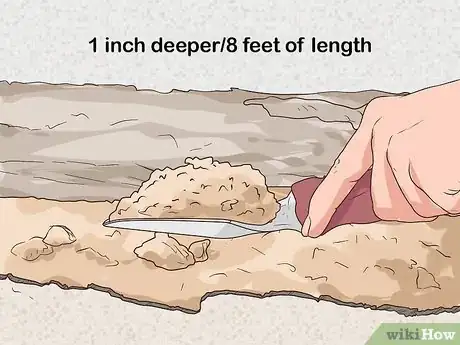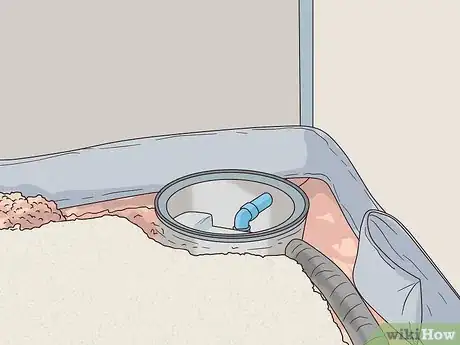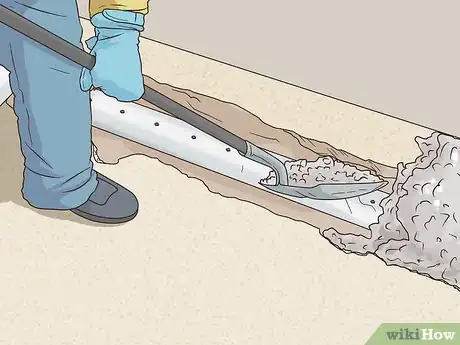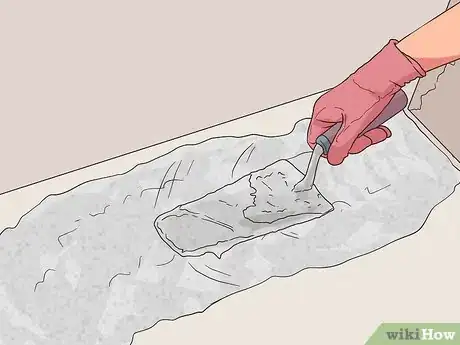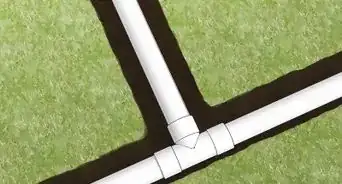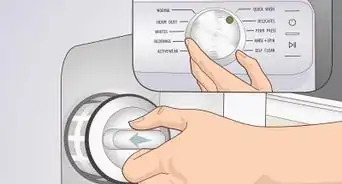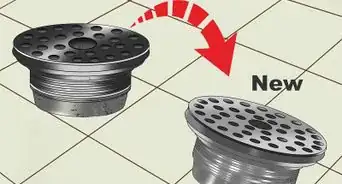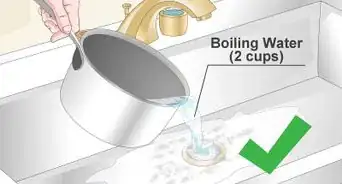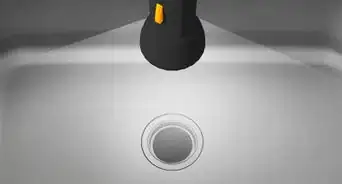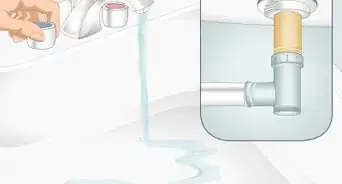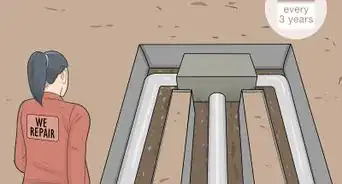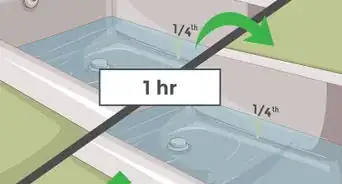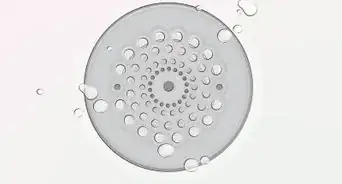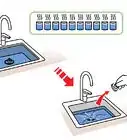This article was co-authored by David Balkan. David Balkan is a Professional Plumber, CEO of Balkan Sewer and Water Main Service, and President of Balkan Sewer and Drain Cleaning. As a hands-on owner of these companies for over 40 years, David is knowledgeable about water service lines, sewers, and drain line issues. David is a Committee Chairman of the Master Plumbers Council and has sat on the Executive Committee of the Sub Surface Plumbers Association of New York for over 30 years. His knowledge and solution-oriented approach contributed to Balkan Sewer and Water Main Service being the largest and most trusted service in New York City and the recipient of the 2017 Angie’s List Super Service Award.
This article has been viewed 119,654 times.
A French drain removes water from a basement by collecting moisture in a shallow trench, pulling it into a perforated pipe, and expelling it to a basin and sump pump. Named after Henry French, who popularized the technology in 1859, the drain is a popular and effective method for drying out basements that are constantly effected by rainwater and other runoff. Because of the need to dig into the foundation of the building, installing a French drain is a major project and should only be tackled by those with significant building or maintenance experience. Before putting a French drain in your basement, you should already have a basin, sump pump, and exterior drain to which the water collected in the basement can flow.[1]
Steps
-
1Plot out and mark the path of the French drain.[2]
- The drain should run about 1 foot (or 30 cm) away from the basement's exterior wall. Place it in the area with the greatest moisture. It should run to a collection basin in the basement (ideally placed in a corner), from which a sump pump will expel the water to the outside.
-
2Dig out the floor of your basement along the path of the drain.[3]
- The trench in which you place the drain should be about 8 inches (or 20 cm) wide and 18 inches (or 45 cm) deep. Use a pickaxe or a jackhammer to break through the floor of the basement. Remove the soil beneath with a shovel.
Advertisement -
3Grade the bottom of the trench.[4]
- Your drain needs to slope downwards in order to effectively carry water to the basin. Tamp down the soil at the bottom of the trench with your shovel, and make the trench 1 inch (or 2.5 cm) deeper for every 8 feet (or 2.4 meters) of length. For example, if you have a trench that is 24 feet (or 7.2 meters) long, the end of the trench should be 3 inches (or 7.5 cm) deeper than the beginning.
-
4Place the French drain piping into the trench with the perforations facing down.[5]
-
5Connect the piping to the water collection basin.[6]
-
6Fill the trench around the piping with drainage gravel.[7]
- The drainage gravel allows water to seep down to the bottom of the trench, where it goes into the perforated holes into the piping and flows into the basin. Make sure the trench is filled with gravel all around the piping, including on top, but do not pack the gravel down tight. Cover the gravel with tyvek and tuck under the outside edges (this is to try and keep the cement from seeping into the gravel)
-
7Seal the trench with cement.[8]
- Quick-setting or quick-dry cement is the easiest option for sealing the trench. If water is coming in from below the floor (high water level) then seal over the entire trench. If water is coming in from leaks in the wall then leave a 2 inch (or 5 cm) gap so as to allow water to run down the wall and into the drain. Easiest to take the edge of the tyvek and pull it back, put a 2x6or 8 tall ways in the trench between the tyvek and the floor edge toward the wall (make sure its above the floor level so it can be removed after the cement dries), then let the tyvek drape over the wood. Mix the cement mix with water and pour it over the gravel that lies on top of and to the side of the piping. Tamp down with a trowel. Let dry for 24 hours. Remove the wood to leave a 1 1/2" weep trench.
Community Q&A
-
QuestionDo I need to put any drainage gravel under the pipe?
 Community AnswerAbsolutely, both above and below in order to support any heavy loads instead of having the pipe support anything (and to keep dirt from migrating into and clogging the system). It also allows for some minimal overflow until the pump can catch up. Make sure your piping (black corrugated drain tile) is set at or slightly below the bottom of the foundation's footer.
Community AnswerAbsolutely, both above and below in order to support any heavy loads instead of having the pipe support anything (and to keep dirt from migrating into and clogging the system). It also allows for some minimal overflow until the pump can catch up. Make sure your piping (black corrugated drain tile) is set at or slightly below the bottom of the foundation's footer. -
QuestionWe have a french drainage system in our basement but I want to close off the gap between the wall and floor. We don't have water dripping down the walls so the gap isn't necessary. Can we do this with quick drying cement without hurting the drain?
 Andy OrrCommunity AnswerI could not possibly recommend doing that unless you wanted to render your drain useless. Where will the water run to if it's blocked?
Andy OrrCommunity AnswerI could not possibly recommend doing that unless you wanted to render your drain useless. Where will the water run to if it's blocked? -
QuestionCan I frame a wall leaving the space between the wall and the floor open without blocking it at all?
 Community AnswerAre you refering to a "floating wall"? If a basement, (any) wall is not going to be load bearing, it can "float" top or bottom of wall (usually bottom) with large spikes into floor material. These floats are used for expansion and contraction of the structure so the walls wont bind and crack concrete, sheetrock, etc.
Community AnswerAre you refering to a "floating wall"? If a basement, (any) wall is not going to be load bearing, it can "float" top or bottom of wall (usually bottom) with large spikes into floor material. These floats are used for expansion and contraction of the structure so the walls wont bind and crack concrete, sheetrock, etc.
Warnings
- Do not use limestone gravel in your pipe trench. Limestone can degrade with moisture and produce a viscous, cement-like substance that will clog your pipes. Always use drainage gravel.⧼thumbs_response⧽
Things You'll Need
- 4-inch diameter perforated French drain piping
- Water basin
- Sump pump
- Exterior drain
- Pickaxe or jackhammer
- Shovel
- Trowel
- Drainage gravel
- Quick-setting cement
References
- ↑ https://www.angieslist.com/articles/how-much-does-french-drain-cost.htm
- ↑ https://www.bobvila.com/articles/basement-drains/
- ↑ https://www.familyhandyman.com/basement/drying-a-wet-basement/
- ↑ https://www.familyhandyman.com/basement/drying-a-wet-basement/
- ↑ https://www.youtube.com/watch?v=iBbvdki9b4g
- ↑ https://www.angieslist.com/articles/how-much-does-french-drain-cost.htm
- ↑ https://www.squareoneinsurance.com/us/perimeter-drain-system
- ↑ https://www.angieslist.com/articles/how-much-does-french-drain-cost.htm


